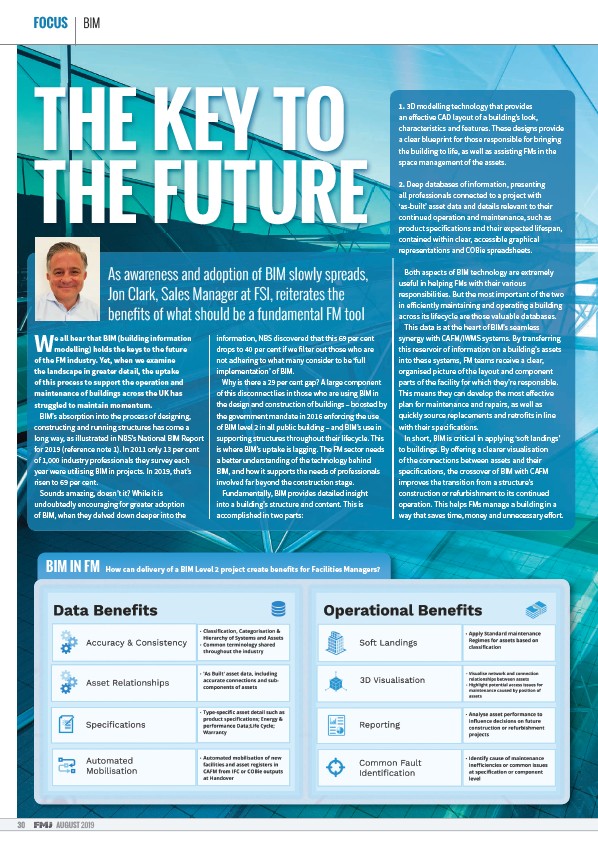
FOCUS BIM
THE KEY TO
THE FUTURE
We all hear that BIM (building information
modelling) holds the keys to the future
of the FM industry. Yet, when we examine
the landscape in greater detail, the uptake
of this process to support the operation and
maintenance of buildings across the UK has
struggled to maintain momentum.
BIM’s absorption into the process of designing,
constructing and running structures has come a
long way, as illustrated in NBS’s National BIM Report
for 2019 (reference note 1). In 2011 only 13 per cent
of 1,000 industry professionals they survey each
year were utilising BIM in projects. In 2019, that’s
risen to 69 per cent.
Sounds amazing, doesn’t it? While it is
undoubtedly encouraging for greater adoption
of BIM, when they delved down deeper into the
30 AUGUST 2019
information, NBS discovered that this 69 per cent
drops to 40 per cent if we filter out those who are
not adhering to what many consider to be ‘full
implementation’ of BIM.
Why is there a 29 per cent gap? A large component
of this disconnect lies in those who are using BIM in
the design and construction of buildings – boosted by
the government mandate in 2016 enforcing the use
of BIM level 2 in all public building – and BIM’s use in
supporting structures throughout their lifecycle. This
is where BIM’s uptake is lagging. The FM sector needs
a better understanding of the technology behind
BIM, and how it supports the needs of professionals
involved far beyond the construction stage.
Fundamentally, BIM provides detailed insight
into a building’s structure and content. This is
accomplished in two parts:
1. 3D modelling technology that provides
an e‘ ective CAD layout of a building’s look,
characteristics and features. These designs provide
a clear blueprint for those responsible for bringing
the building to life, as well as assisting FMs in the
space management of the assets.
2. Deep databases of information, presenting
all professionals connected to a project with
‘as-built’ asset data and details relevant to their
continued operation and maintenance, such as
product specifications and their expected lifespan,
contained within clear, accessible graphical
representations and COBie spreadsheets.
Both aspects of BIM technology are extremely
useful in helping FMs with their various
responsibilities. But the most important of the two
in e‘ iciently maintaining and operating a building
across its lifecycle are those valuable databases.
This data is at the heart of BIM’s seamless
synergy with CAFM/IWMS systems. By transferring
this reservoir of information on a building’s assets
into these systems, FM teams receive a clear,
organised picture of the layout and component
parts of the facility for which they’re responsible.
This means they can develop the most e‘ ective
plan for maintenance and repairs, as well as
quickly source replacements and retrofits in line
with their specifications.
In short, BIM is critical in applying ‘so˜ landings’
to buildings. By o‘ ering a clearer visualisation
of the connections between assets and their
specifications, the crossover of BIM with CAFM
improves the transition from a structure’s
construction or refurbishment to its continued
operation. This helps FMs manage a building in a
way that saves time, money and unnecessary e‘ ort.
As awareness and adoption of BIM slowly spreads,
Jon Clark, Sales Manager at FSI, reiterates the
beneƛ ts of what should be a fundamental FM tool
BIM IN FM How can delivery of a BIM Level 2 project create benefits for Facilities Managers?